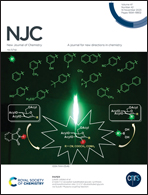Ruthenium-hydride-mediated stabilisation of the azo anion radical of azobis(benzothiazole) and its reversible electron-reservoir feature†
Abstract
The study addresses the question of stabilisation of the azo anion radical state of azobis(benzothiazole) (abbt, L) on a selective ruthenium platform without the involvement of direct intramolecular electron transfer (IET) or solvent oxidation, as has been demonstrated earlier, and its reversible electron-reservoir feature were investigated. Specifically, the ruthenium-hydride metal precursor (RuII(H)(Cl)(CO)(PPh3)3)-mediated stabilisation of the azo anion radical of abbt derivatives in RuII(L˙−)(Cl)(CO)(PPh3)2 (1: L1 = 2,2′-azobis(benzothiazole), 2: L2 = 2,2′-azobis(6-methylbenzothiazole), 3: L3 = 2,2′-azobis(6-chlorobenzothiazole)) without the alteration of the metal oxidation state (RuII). The radical state of L˙− in 1–3 (S = 1/2, μeff/B.M. = 1: 1.83, 2: 1.78, 3: 1.86 in CDCl3 at 298 K, determined by Evans method) displayed free radical electron paramagnetic resonance (EPR) (g ≈ 2.0) with the partial resolution of nitrogen hyperfine splitting. The effective role of the Ru–H metal precursor towards the {L0–RuII–H} → {RuII–L˙− + 1/2 H2} transformation in 1–3 was corroborated by the detection of H2 gas from the reaction mixture as well as by its calculated favourable thermodynamic parameters (ΔG: −76 to −84 kcal mol−1). Moreover, the low oxidation potential of L˙− → L0 in 1–3 (0.14–0.31 V versus SCE) facilitated the isolation of the corresponding oxidised complexes [RuII(L0)(Cl)(CO)(PPh3)2]ClO4 ([1]ClO4, [2]ClO4, [3]ClO4) by using AgClO4 as the chemical oxidant. The structural evaluation of [1]ClO4 to [3]ClO4 revealed: (i) a lengthening of the azo bond (N1–N4 > 1.3 Å) with respect to the corresponding free ligand (L ≈ 1.25 Å) due to dπ(RuII) to π*(azo) back bonding and (ii) the planar/slightly non-planar L2, L1/L3 (torsional angle: 8.09°, 9.07°) introduced two equivalent and inequivalent PPh3 co-ligands in [2]ClO4, [1]ClO4, and [3]ClO4, respectively. The L0 state in 1+–3+ could also be reduced to L˙− in 1–3 by hydrazine hydrate, attributed to its reversible electron-reservoir feature. Also, 1n–3n (n = 1, 0, −1) exhibited mixed metal–ligand-based charge-transfer transitions in the UV-visible region as a function of L and n.



 Please wait while we load your content...
Please wait while we load your content...